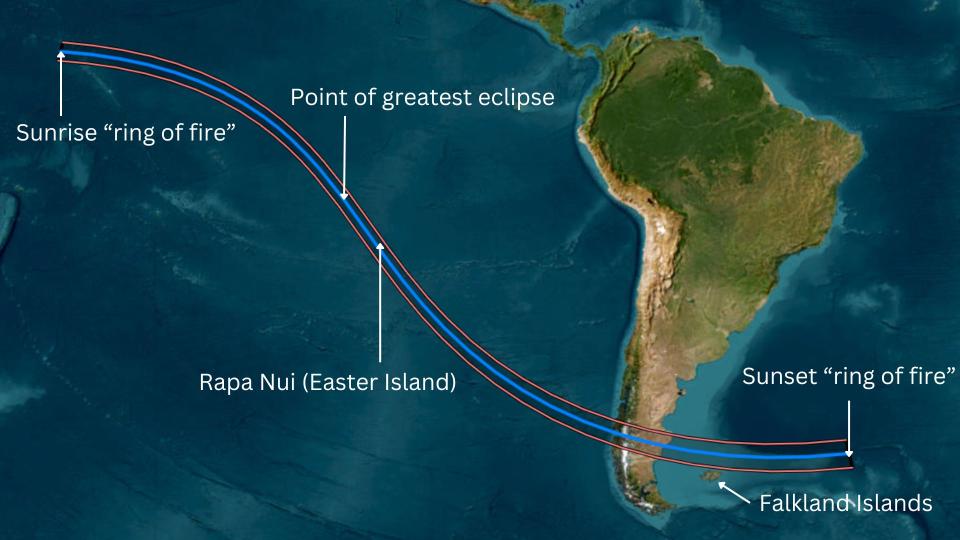Where can I see the annular solar eclipse on Oct. 2, 2024?
When you buy through links on our articles, Future and its syndication partners may earn a commission.

An annular solar eclipse will occur on Oct. 2, 2024, when the moon's central shadow will not quite reach Earth. This will create a "ring of fire" effect visible to observers within a wide path stretching across the Pacific Ocean and southern South America.
At the point of greatest eclipse in the Pacific, the moon will obscure 93% of the sun's center, creating a "ring of fire" visible for 7 minutes and 25 seconds.
Related: 16 best places to see the annular 'ring of fire' solar eclipse 2024
During an annular solar eclipse, it is NEVER safe to look directly at the sun without solar eclipse glasses designed for solar viewing. Read our guide on how to observe the sun safely.
This annular solar eclipse has a long and broad path, rising south of Hawaii in the North Pacific Ocean and setting north of South Georgia in the South Atlantic Ocean. That journey is a mighty 8,800 miles (14,163 kilometers), with the path between 165 and 206 miles (265 to 331 km) wide. Very little of it crosses land, with only Rapa Nui (Easter Island) and southern parts of Chile and Argentina in South America within the path of annularity.

The path of annularity: Rapa Nui (Easter Island)

It's a marvel that the 'ring of fire' will be visible from this remote volcanic island in the South Pacific, halfway between Tahiti and South America. It's been only 14 years since a total solar eclipse was visible from here on July 11, 2010.
About 2,200 miles (3,540 km) west of Chile, Rapa Nui is home to 1,000 mysterious moai, the remnants of a culture from the 13th–16th centuries. Perched on stone pedestals called ahus, these carved human figures can be found at several sites on the island, which is entirely within the eclipse's path.
The 'ring of fire' will hang 67 degrees above north and last 6 minutes 28 seconds at Rapa Nui's most southerly point, Orongo, and 5 minutes 59 seconds at its most northerly point, Ana o Heu.
Related: What's the difference between a total solar eclipse and an annular solar eclipse?
The path of annularity: South America

Barely 1,000 miles (1,600 km) of the 8,800 miles (14,163 km) path of annularity crosses land on Oct. 2, 2024, the vast majority of it in southern South America and two countries in particular — Chile and Argentina. Chile's Pacific Coast is difficult to access, but Carretera Austral (also called Route 7) dissects the path in rural Patagonia's Aisén region. As it strikes Chile, the eclipse will be 26 degrees above the north-northwest horizon, with the lower elevation arguably creating a more dramatic sight than from Rapa Nui (Easter Island).
Key locations in Chile include Cochrane, close to the centerline (south along the Carretera Austral), and Chile Chico, just outside the northern limit, close to the border with Argentina. The latter would be a good choice for anyone wanting to see extended displays of Baily's beads, which could last a few minutes.
In Argentina, a choice location in a wild, empty region could be Perito Moreno National Park. For a more arid eclipse with the highest chances of a clear sky anywhere in the path, choose Puerto Deseado and Puerto San Julián in Santa Cruz Province on Argentinean Patagonia's Atlantic coast.
The next annular solar eclipse: 2024 vs 2027

On average, a central solar eclipse occurs in the same place twice every 366 years or so, according to NASA, but two-and-a-half years after 2024's annular solar eclipse, another happens partly in the same place. On Feb. 6, 2027, a 7-minute and 51-second 'ring of fire' will again be visible again from Chile and Argentina.
The 2024 and 2027 paths cross just off the coast of Chile in the Pacific Ocean. In 2027, the path will cross Chile slightly to the north of the 2024 path, while in Argentina, it swerves through central Patagonia and misses the capital city, Buenos Aires. It also just missees Montevideo, the capital of Uruguay, shaving that country's southeast coast before traveling across the Atlantic to show a 'ring of fire' sunset to those in C?te d'Ivoire, Ghana, Togo, Benin and Nigeria.
Additional resources
Want to look further ahead? You can find a concise summary of solar eclipses out to 2030 on NASA's eclipse website. Read more about solar and lunar eclipses on EclipseWise.com, a website dedicated to predictions of eclipses. See beautiful maps on eclipse cartographer Michael Zeiler's GreatAmericanEclipse.com and interactive Google Maps on Xavier Jubier's eclipse website. You can find climate and weather predictions by meteorologist Jay Anderson on eclipsophile.com.
Bibliography
Anderson, J. (February 2024). Annular Solar Eclipse
2024 October 2. Retrieved April 24, 2024, from https://eclipsophile.com/annular-solar-eclipse-october-2-2024/
Bakich, M. and Zeiler, M. (2022). Atlas Of Solar Eclipses 2020-2045.
https://www.greatamericaneclipse.com/books/atlas-of-solar-eclipses-2020-to-2045
Espenak, F. Solar Eclipse Prime Page: Annular Solar Eclipse of 2024 October 2. Retrieved April 24, 2024, from: https://eclipsewise.com/solar/SEprime/2001-2100/SE2024Oct02Aprime.html
Jubier, X. (n.d.). Solar eclipses: Interactive Google Maps. Retrieved April 24, 2024, from https://xjubier.free.fr/en/site_pages/SolarEclipsesGoogleMaps.html
Time and Date. (n.d.). October 2 2024 Annular Solar Eclipse. Retrieved April 24, 2024 from https://www.timeanddate.com/eclipse/solar/2024-october-2
